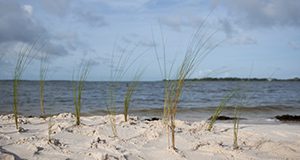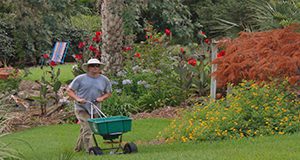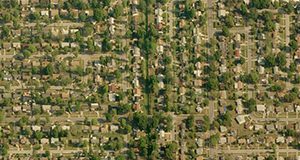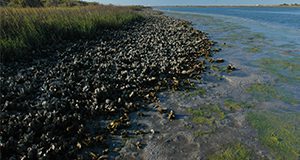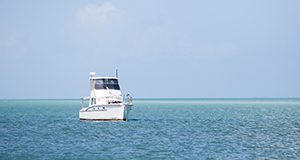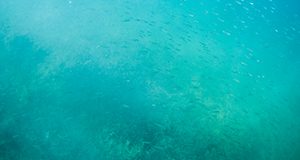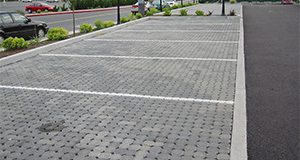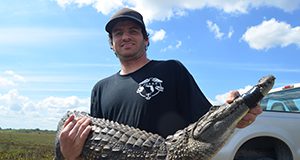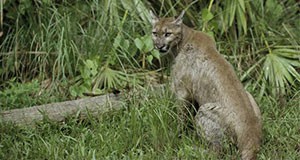The impacts of sea level rise on ecosystems and natural resources are a major concern in Florida, especially in low-lying coastal areas such as south Florida. Sea level rise can impact many aspects of Florida's economy, including urban development, agriculture, infrastructure, and natural areas. This 16-page document introduces, evaluates, and summarizes selected available online sources and tools to educate diverse stakeholders and concerned local residents on important aspects of sea level rise. Written by Young Gu Her, Ashley Smyth, Jiangxiao Qiu, Elias Bassil, Ulrich Stingl, and Laura Reynolds, and published by the UF/IFAS Department of Agricultural and Biological Engineering, June 2020.
https://edis.ifas.ufl.edu/ae543
Category: Getting Involved
Urban Fertilizer Ordinances in the Context of Environmental Horticulture and Water Quality Extension Programs: Frequently Asked Questions
Excess nitrogen (N) and phosphorus (P) in water bodies are a leading cause of water quality degradation statewide. More than 50 Florida counties and municipalities now have formal fertilizer ordinances, which in some cases include fertilizer blackouts, or bans on the usage of N and P fertilizers during certain times of the year. This 8-page document provides information on the underlying issues of fertilizer use, with an emphasis on an urban setting, and outlines the current state of the science on urban fertilizers and water quality in Florida. Written by Michael D. Dukes, Lisa Krimsky, Mary Lusk, Laurie Trenholm, Bryan Unruh, Michelle Atkinson, and Rao Mylavarapu, and published by the UF/IFAS Department of Agricultural and Biological Engineering, February 2020.
https://edis.ifas.ufl.edu/ae534
Residential Irrigation Water Costs in Osceola County and Orange County, Florida
Interest in understanding water use and irrigation costs has risen in recent years. This case study is a 5-page evaluation of water use and associated costs for residential landscape irrigation in Osceola County and Orange County, Florida. Homeowners in central Florida can use the results to assess their water consumption and bills in relation to similar homes in the area. Written by Nick Taylor, Tricia Kyzar, Pierce Jones, and Kaitlin O. Robb Price, and published by the UF/IFAS Department of Agricultural and Biological Engineering, December 2019.
https://edis.ifas.ufl.edu/ae536
Cetaceans 4th Grade Curriculum–Lesson 9: How Do Whales Stay Warm?
This 9-page document is the ninth lesson in the Cetaceans 4th Grade Curriculum. It will help students investigate the roles that blubber, body shape, and body size play in preventing heat loss in marine mammals. Written by Maia Patterson McGuire and Ruth Francis-Floyd, and published by the UF/IFAS Veterinary Medicine–Large Animal Clinical Sciences Department, June 2019.
http://edis.ifas.ufl.edu/vm234
Cetaceans 4th Grade Curriculum–Lesson 16: North Atlantic Right Whales and Ship Strikes
This 7-page document is the sixteenth lesson in the Cetaceans 4th Grade Curriculum. It will help students learn why ship strikes are a threat to North Atlantic right whale survival, and what conservation measures are in place to reduce this threat. Written by Maia Patterson McGuire, Jessica Hardy, Brenda Cannaliato, and Ruth Francis-Floyd, and published by the UF/IFAS Veterinary Medicine–Large Animal Clinical Sciences Department, June 2019.
http://edis.ifas.ufl.edu/vm241
Cetaceans 4th Grade Curriculum–Lesson 4: How Big Are Cetaceans?
This 12-page document is the fourth lesson in the Cetaceans 4th Grade Curriculum. It will help students gain an understanding of the size of different cetaceans through engaging activities. Written by Maia Patterson McGuire and Ruth Francis-Floyd, and published by the UF/IFAS Veterinary Medicine–Large Animal Clinical Sciences Department, June 2019.
http://edis.ifas.ufl.edu/vm229
Cetaceans 4th Grade Curriculum–Lesson 12: Identifying Individual North Atlantic Right Whales
This 4-page document is the twelfth lesson in the Cetaceans 4th Grade Curriculum. It will help students learn about the New England Aquarium’s right whale database and match photographs of individual right whales. Written by Maia Patterson McGuire, Ruth Francis-Floyd, and Brenda Cannaliato, and published by the UF/IFAS Veterinary Medicine–Large Animal Clinical Sciences Department, June 2019.
http://edis.ifas.ufl.edu/vm237
Cetaceans 4th Grade Curriculum–Lesson 8: Food Chains
This 6-page document is the eighth lesson in the Cetaceans 4th Grade Curriculum. It will help students identify components of baleen and toothed whale food chains and trace energy flow. Written by Maia Patterson McGuire, Brenda Cannaliato, and Ruth Francis-Floyd, and published by the UF/IFAS Veterinary Medicine–Large Animal Clinical Sciences Department, June 2019.
http://edis.ifas.ufl.edu/vm233
Cetaceans 4th Grade Curriculum–Lesson 3: Researching Individual Whale and Dolphin Species
This 55-page document is the third lesson in the Cetaceans 4th Grade Curriculum. It will help students learn about individual cetacean species through a game. Written by Maia Patterson McGuire and Ruth Francis-Floyd, and published by the UF/IFAS Veterinary Medicine–Large Animal Clinical Sciences Department, June 2019.
http://edis.ifas.ufl.edu/vm228
Cetaceans 4th Grade Curriculum–Lesson 2: Cetaceans–What Makes a Whale a Whale?
This 7-page document is the second lesson in the Cetaceans 4th Grade Curriculum. It will help students learn about general whale and dolphin biology. Written by Ruth Francis-Floyd and Maia Patterson McGuire, and published by the UF/IFAS Veterinary Medicine–Large Animal Clinical Sciences Department, June 2019.
http://edis.ifas.ufl.edu/vm227
Cetaceans 4th Grade Curriculum–Lesson 1: Starting to Learn about Whales
This 14-page document is the first lesson in the Cetaceans 4th Grade Curriculum. It will help students start to learn about whales and practice reading comprehension and writing skills. Written by Maia Patterson McGuire and Ruth Francis-Floyd, and published by the UF/IFAS Veterinary Medicine–Large Animal Clinical Sciences Department, June 2019.
http://edis.ifas.ufl.edu/vm226
Cetaceans 4th Grade Curriculum–Outline
The Cetaceans 4th Grade Curriculum provides a series of individual lessons covering cetacean (whale and dolphin) biology and ecology. The curriculum uses charismatic megafauna to engage students and inspire them to want to learn more. This 3-page document provides a brief overview of the Cetaceans 4th Grade Curriculum. Written by Maia Patterson McGuire and Ruth Francis-Floyd, and published by the UF/IFAS Veterinary Medicine–Large Animal Clinical Sciences Department, June 2019.
http://edis.ifas.ufl.edu/vm225
Cetaceans 4th Grade Curriculum–Lesson 13: North Atlantic Right Whale Migration
This 6-page document is the thirteenth lesson in the Cetaceans 4th Grade Curriculum. It contains information that will help students learn about the migration path of North Atlantic right whales and the ways researchers are studying the movement of these whales. Written by Maia Patterson McGuire and Ruth Francis-Floyd, and published by the UF/IFAS Veterinary Medicine–Large Animal Clinical Sciences Department, June 2019.
http://edis.ifas.ufl.edu/vm238
Bioplastics: a better option for the environment?
Most modern-day plastics are made from petroleum, but several different types of plastics are made from plant or even bacterial sources. This 4-page fact sheet written by Maia Patterson McGuire and published by the UF/IFAS School of Forest Resources and Conservation describes four types of these bioplastics and explains why, even if a bioplastic item is listed as “compostable,” a reusable, washable alternative is often the better choice.
http://edis.ifas.ufl.edu/fr418
Permeable Pavement Systems: Technical Considerations
Permeable pavement systems are Green Stormwater Infrastructure practices that can reduce runoff while supporting vehicle and pedestrian traffic. This new 8-page document provides technical details of permeable pavement systems, such as application, system elements, design, installation, operation, maintenance, crediting, and costs, in order to inform planners, engineers, landscape architects, local government officials, and other professionals in the built environment about the considerations for implementing and maintaining permeable pavements. Written by E. Bean, M. Clark, and B. Larson, and published by the UF/IFAS Department of Agricultural and Biological Engineering, April 2019.
http://edis.ifas.ufl.edu/ae530
Everglades Invasive Reptile and Amphibian Monitoring Program: Summary of the First Five Years
South Florida has more nonnative species of reptiles and amphibians than anywhere else in the world. Some of these species become invasive and harm the environment, economy, and/or public health. Once populations are widely established, management becomes expensive, long-term, and often ineffective. Early detection and rapid response offers the best chance to contain or eradicate populations before they can spread and become unmanageable. Toward that end, the Everglades Invasive Reptile and Amphibian Monitoring Program provides a scientific framework for monitoring invasive reptiles and amphibians in south Florida. It also monitors native reptiles, amphibians, and mammals to assess impacts of invasive species.
This 5-page fact sheet written by Rebecca G. Harvey, Mike Rochford, Jennifer Ketterlin Eckles, Edward Metzger III, Jennifer Nestler, and Frank J. Mazzotti and published by the Wildlife Ecology and Conservation Department lists the objectives, activities, and accomplishments of the program over its first five years, and it describes some ways Floridians and visitors to the state can help with the effort.
http://edis.ifas.ufl.edu/uw431
Land Trusts in Florida: A Brief Guide to Land Trusts
A land trust is a private nonprofit organization that owns and manages land to protect its natural, economic, and cultural value. Land trusts may also educate the public about local conservation efforts. This two-page factsheet written by Benjamin W. North and Elizabeth F. Pienaar and published by the UF/IFAS Department of Wildlife Ecology and Conservation explains the important role land trusts play and provides tips on how to establish a land trust to protect land in your community.
http://edis.ifas.ufl.edu/uw436
Improving, Restoring, and Managing Natural Resources on Rural Properties in Florida: Sources of Financial Assistance
Interested in conserving natural resources, such as wildlife habitat, or protecting the agricultural heritage of your land? Both federal and state governments have technical and financial assistance programs to help rural landowners achieve natural resource goals. These challenges are addressed through land rentals, technical assistance, cost-shares, and incentive payments and include both time-limited and permanent land-use options.
This 8-page fact sheet written by Chris Demers, Martin B. Main and Mark E. Hostetler and published by the UF School of Forest Resources and Conservation informs landowners about government programs available to help conserve natural resources.
http://edis.ifas.ufl.edu/fr156
Conservation Reserve Program: Overview and Discussion

The Conservation Reserve Program, a governmental initiative with the goal of protecting the environment by retiring less productive but environmentally sensitive cropland from production, is by far the largest-scale, biggest-budgeted conservation program in the United States. The program has been a success, improving the land allocation of primary crop production and providing environmental benefits, but it is currently confronted with government budget cuts, and some farmers are reluctant to participate. This 5-page fact sheet written by Juhyun Oh and Zhengfei Guan and published by the Food and Resource Economics Department provides an overview of the Conservation Reserve Program and discusses relevant issues for Florida.
http://edis.ifas.ufl.edu/fe973
Basics of Quantifying N Sources and Fates on the University of Florida Campus
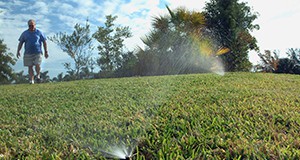 Landscapes, recreational areas, and sports fields are important parts of the University of Florida campus that receive nitrogen (N) fertilization to maintain the health and quality of their plants. However, nitrogen can be lost from the landscape through runoff in storm water or leaching into groundwater, both fates leading to pollution of the receiving water bodies. Human activities can also cause losses of nitrogen. Therefore, educating people about nitrogen cycling in the urban environment is critical for the development of solutions to the environmental problems caused by nitrogen loss. This 5-page fact sheet discusses nitrogen mass budgets, land uses in a major university, and nitrogen sources and fates associated with different land uses on campus. Written by Jiexuan Luo and George Hochmuth, and published by the UF Department of Soil and Water Science.
Landscapes, recreational areas, and sports fields are important parts of the University of Florida campus that receive nitrogen (N) fertilization to maintain the health and quality of their plants. However, nitrogen can be lost from the landscape through runoff in storm water or leaching into groundwater, both fates leading to pollution of the receiving water bodies. Human activities can also cause losses of nitrogen. Therefore, educating people about nitrogen cycling in the urban environment is critical for the development of solutions to the environmental problems caused by nitrogen loss. This 5-page fact sheet discusses nitrogen mass budgets, land uses in a major university, and nitrogen sources and fates associated with different land uses on campus. Written by Jiexuan Luo and George Hochmuth, and published by the UF Department of Soil and Water Science.
http://edis.ifas.ufl.edu/ss641
